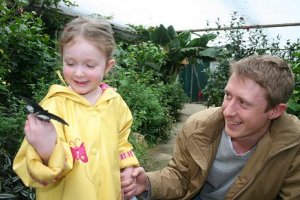History

The centre is the dream come true of horticulturalist Tony Miller, who began his lifelong love affair with the garden and landscape in his teens as a council parks gardener. The realisation of his great project has not been easy, he has had to overcome objections from county planning officers and councillors who claimed it would generate too much traffic!
He is now semi-retired and devotes part of each week to the further development of the centre.
He began to buy the Studley Grange Garden and Leisure Project during the 1980s when he bought 25 acres of former water meadows at Studley Grange Farm. He has already achieved the first part of his concept of turning the project into a major tourist attraction, as well as a service for all interested in gardening and landscaping.
About Butterfly World

Welcome to Studley Grange Butterfly World
A tropical paradise has been created in the centre of what was a desolate stretch of redundant farm fields and marshland in South Wiltshire. It has now been transformed into a butterfly farm and animal park.
The butterfly farm is the jewel in the crown of a complex that includes art and handicraft units, ceramic and stained glass workshops, painting and photographic studios, together with a garden centre that is one of the most up-to-date and comprehensive in its range in the country.
At Butterfly World, one of the largest in Britain, visitors can see up to 30 species of butterfly - with hundreds flying around at any one time - in the 600 sq m hot house. Over 200 varieties of tropical plant add colour and exotica to the atmosphere in the attractively laid out centre, with its little streams and rustic bridges, waterfalls and fishponds.
You may be lucky enough to see a butterfly emerging from its pupae. Enter the reptile room where you will come face to face with snakes, lizards, frogs and a tarantula. Visitors can also feed our very hungry koi.
Studley Grange Butterfly World is privately owned and receives no financial support from local Government or any other body. We rely entirely on admission charges, gift shop purchases and Cafe purchases to survive.
F.A.Q.
What are butterflies and moths?
Butterflies and moths belong to a group of insects called Lepidoptera. Like all insects, they have a head, thorax, abdomen, two antennae, and six legs. Additionally, moths and butterflies have four wings that are almost always covered by coloured scales, and a coiled proboscis for drinking liquids.
Lepidoptera is derived from the Latin "lepido"= scale + "ptera" = wing.
How many different kinds of moths and butterflies are there in the world?
There are about 20,000 species of butterflies and more than 200,000 species of moths.
What is the difference between butterflies and moths?
Butterflies are mostly brightly coloured day-flying insects with clubbed antennae and most moths fly at night and have tapered or feathery antennae. When resting, moths generally fold their wings down and butterflies close them over their backs. However there are exceptions in both butterflies and moths.
What do butterflies feed on?
Caterpillars feed mainly on plant parts. Adult butterflies eat liquids. They sip flower nectar and imbibe fluids from sap on trees, rotting fruits, bird droppings, or animal dung. Adult butterflies can usually be found drinking fluids at wet sand or mud, along stream edges or on dirt tracks.
What is a group of butterflies called?
A group of butterflies is called a ''''Kaleidoscope''''.
Others have called it a ''''Swarm'''' or ''''Rabble''''.
What are a butterfly's wings made of?
Touch the wing of a butterfly or moth, and you will find dust on your fingers. These are tiny scales. Butterfly wings are clear but covered with tiny scales. These scales create the beautiful colour patterns we see. They also help in absorbing or reflecting sunlight. It is generally not a good idea to touch a butterfly's wings.
What is the butterfly life cycle?
Butterflies go through complete metamorphosis. Egg-caterpillar-pupae-adult.
How long do butterflies live?
A Butterflies life span averages from about 2 to 21 days after they emerge from the pupae, but some can live up to 11 months. Females generally live longer than males.
What is the largest and the smallest butterfly?
Smallest is the Western Pygmy Blue. Wingspan 1.5cm.
Largest is Queen Alexandra's Birdwing. Wingspan 28cm.




